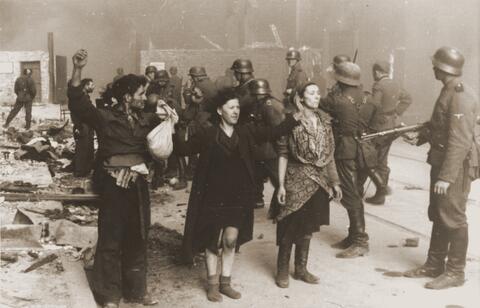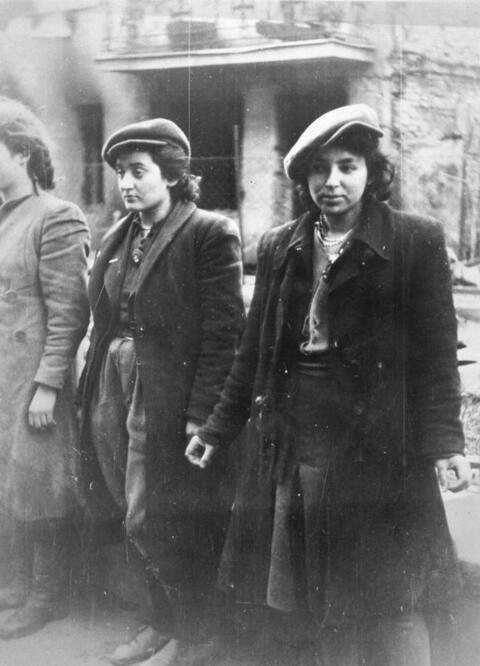The Warsaw Ghetto Uprising
Joining the Resistance
Throughout their imprisonment in the ghettos, Jews had found ways to defy and resist Nazi conquerors: they organized mutual aid societies, they continued to practice their religion and educate their children, and they made heroic efforts to document their lives (see reading, Voices from the Warsaw Ghetto in Chapter 8). In more than 100 ghettos, Jews formed underground movements with the goal of escaping the ghetto, joining partisan (armed resistance) groups, or organizing a revolt. Prisoners in several camps, including Auschwitz, Treblinka, and Sobibór, mounted revolts. In Vilna, Bialystock, and several other ghettos, Jews resisted deportations with force. The largest armed resistance by Jews against the Nazis occurred in the Warsaw ghetto.
Capture of Jewish Resistance Fighters

Capture of Jewish Resistance Fighters
Jewish resistance fighters who fought against the SS and German army during the Warsaw ghetto uprising between April 19 and May 16, 1943, are captured.
Introduction to the Jewish Partisans
In 1942, about 300,000 Jews had been deported from the Warsaw ghetto to Treblinka. Only 55,000 remained, mainly men and women without children because children and the elderly had been deported. Some of the “remnants,” as they called themselves, formed the Zydowska Organizacja Bojowa (ZOB), or Jewish Fighting Organization. They reached out to partisan groups and the Polish underground for weapons. They received very few such weapons but were determined to do as much as possible with what they had.
When a new round of deportations began in January 1943, the ZOB struck back, firing on German troops and helping other ghetto residents into prearranged hiding places. Nazi commanders retaliated by executing 1,000 Jews in the main square of the ghetto, but they also briefly stopped the deportations. Surviving Jews made preparations for a major revolt.
April 19, 1943, was the first day of the Jewish holiday of Passover and also the eve of Hitler’s birthday. German General Jürgen Stroop arrived in Warsaw ready to wipe out all opposition within a single day as a birthday gift to his Führer. Stroop had 2,100 soldiers with 13 heavy machine guns, 69 handheld machine guns, 135 submachine guns, several howitzers, and 1,358 rifles. The approximately 750 Jewish resisters had two submachine guns, a handful of rifles, and homemade explosives. But the resisters were able to fight off Stroop’s soldiers for the first few days, and they were able to hold out under siege for four weeks.
Simcha Rotem, a survivor, later told filmmaker Claude Lanzmann: “During the first three days of fighting, the Jews had the upper hand. The Germans retreated at once to the ghetto entrance, carrying dozens of wounded with them.” 1 On April 23, Mordechai Anielewicz, commander of the ZOB, wrote:
What happened exceeded our boldest dreams. The Germans fled twice from the ghetto. One of our companies held its position for forty minutes, while the other one lasted—upwards of six hours . . . My life's dream has become a reality. I have seen the Jewish defense of the ghetto in all its strength and glory. 2
On April 26, Stroop reported to his superiors in Berlin:
The resistance put up by the Jews and bandits could be broken only by relentlessly using all our force and energy by day and night. On 23 April 1943 the Reichsführer SS issued through the higher SS and Police Fuhrer East at Cracow his order to complete the combing out of the Warsaw Ghetto with the greatest severity and relentless tenacity. I therefore decided to destroy the entire Jewish residential area by setting every block on fire, including the blocks of residential buildings near the armament works. . . . Not infrequently, . . . because of the heat and the fear of being burned alive [the Jews] preferred to jump down from the upper stories after having thrown mattresses and other upholstered articles in the street from the burning buildings. With their bones broken, they still tried to crawl across the street into blocks of buildings which had not yet been set on fire or were only partly in flames. Often Jews changed their hiding places during the night, by moving into the ruins of burnt-out buildings, taking refuge there until they were found by our patrols. Their stay in the sewers also ceased to be pleasant after the first week. Frequently from the street, we could hear loud voices coming from the sewer shafts. 3
Rotem described what happened once Stroop’s men began to destroy the ghetto block by block:
The whole ghetto was ablaze. All life vanished from the streets and houses. We hid in the cellars and bunkers. From there we made our sorties. We went out at night. The Germans were in the ghetto mostly by day, leaving at night. They were afraid to enter the ghetto at night. . . .
I don’t think the human tongue can describe the horror we went through in the ghetto. . . . Besides fighting the Germans, we fought hunger and thirst. We had no contact with the outside world; we were completely isolated, cut off from the world. We were in such a state that we could no longer understand the very meaning of why we went on fighting. We thought of attempting a breakout to the Aryan part of Warsaw, outside the ghetto. 4
The Nazis finally put down the uprising on May 16 by destroying the ghetto and sending any survivors to death or labor camps. Anielewicz did not survive. Rotem and Marek Edelman were among the few to escape through the sewers to the “Aryan” part of Warsaw. Others took their own lives before the Nazis could reach them.
More than 70 years later, Holocaust scholar Michael Berenbaum told Edelman and Rotem that he and other historians had concluded that “resistance meant all but certain death for all within the ghetto . . . and the only issue was how to face the reality of impending death.” The conversation continued:
“Professor,” Edelman said with barely concealed disdain that fighters have toward those who have never been in combat, “Professor, resistance was a choice with how to live in the moments before we died.”
Death was a given. How to live in the interim was not. . . . 5
- 1Claude Lanzmann, Shoah: An Oral History of the Holocaust; The Complete Text of the Film (New York: Pantheon Books, 1985), 197–98. Reproduced by permission of Georges Borchardt, Inc. and Librairie Arthème Fayard.
- 2Quoted in “Fighters in the Warsaw Ghetto,” Yad Vashem, accessed July 8, 2016.
- 3Roderick Stackelberg and Sally A. Winkle, eds. The Nazi Germany Sourcebook: An Anthology of Texts (London: Routledge, 2002), 368.
- 4Claude Lanzmann, Shoah: An Oral History of the Holocaust; The Complete Text of the Film (New York: Pantheon Books, 1985), 197–98. Reproduced by permission of Georges Borchardt, Inc. and Librairie Arthème Fayard.
- 5 Michael Berenbaum, “Some Clarifications on the Warsaw Ghetto Uprising,” in Life in the Ghettos During the Holocaust, ed. Eric J. Sterling (Syracuse: Syracuse University Press, 2005), 22–23.
Warsaw Ghetto Uprising Resisters

Warsaw Ghetto Uprising Resisters
Three members of the Jewish Fighting Organization caught after the Warsaw ghetto uprising. They worked in an underground workshop, making hand grenades and other explosives for the uprising.
Connection Questions
- What motivated members of the ZOB and other Jews in the Warsaw ghetto to take part in the armed resistance? How was their resistance similar to other examples of resistance that you have learned about in Chapters 8 and 9? How was it different?
- Compare and contrast the accounts of the uprising given by General Jürgen Stroop and survivor Simcha Rotem. What does each reveal? How do they differ? How would our understanding of these events be different if we had only Stroop’s report?
- Scholar Michael Berenbaum wrote that for those who resisted, “Death was a given.” With such terrible odds against them, why did so many Jews participate in the Warsaw ghetto uprising? Did their resistance matter?
Get the Handout
How to Cite This Reading
Facing History & Ourselves, "The Warsaw Ghetto Uprising," last updated August 2, 2016.
This reading contains text not authored by Facing History & Ourselves. See footnotes for source information.








